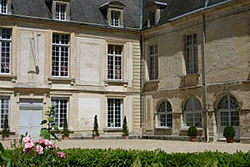Château de Condé


The Château de Condé is a private estate in Condé-en-Brie, Aisne, France, set in a park on the Champagne route 100 km from Paris.
The Château de Condé is a private estate, listed as a historic monument and inhabited year round. Its 17th and 18th century interiors were created by artists (
History
The village of
The village derives its name from the confluence of two rivers, the Surmelin and the Dhuys, which merge before feeding the river Marne: Condé derives from the Celtic word condatum, meaning "confluent".
The castle's history during the Middle Ages was closely linked to the
The last heir of the House of Coucy,
Cardinal
Up to 1624, the date of the marriage of


The confiscated castle was bought in 1719 by a private secretary of King Louis XIV, whose name was
The Marquis was a member of the
Much of the castle's final appearance is due to the Marquis' tastes. He brought to Condé, the talents of the Italian architect Servandoni, a master of the "deception" style, and one of the architects of the
At a later date, the castle belonged to the Count de la Tour du Pin Lachaux, through his marriage with the niece of the Marquis de la Faye. In 1814, the Countess de Sade, the daughter-in-law of the famous Marquis de Sade, inherited Condé from her cousin, La Tour du Pin. Since this time and up to 1983, the castle remained the property of the Sade family, who restored it with much care after the two World Wars.
Restoration
In 1983, Alain Pasté de Rochefort purchased the chateau which had been for sale for many years. Here he did not feel a stranger since his ancestor Captain Pasté was in the 16th century one of the two captains of the first Prince of Condé's personal guard. He was restless and, with the help of the Administration of Historical Monuments, started a series of works: the roofs were repaired, including those of dependencies such as "La Porterie" and "La Capitainerie" as well as the 17 fireplaces, gutters and stonework. Restoration of the façades could then begin, along with the grand staircase or the small apartments whose woodwork and parquet needed to be partly dismantled. The Watteau wing, which had suffered in both wars, had its colours restored. Each room evokes Watteau and his followers (Lancret and Pater) who painted landscapes, "fêtes galantes", tales by Jean de la Fontaine painted on the walls. While some paintings were hidden (behind wallpaper or mirrors), they were later discovered after many years of restoration.
Gallery
-
Bedroom of Cardinal de Richelieu
-
Bedroom of Olympe
-
Bedroom of the Musician (detail of the Watteau wing)
-
Escalier d'honneur
Book sources
- Glorieux, Guillaume, 2004: Le Château de Condé – Demeure des Princes. Paris: Somogy. ISBN 2-85056-759-0.
External links
- Château de Condé official website.
- Blandine Verlet plays Froberger on the original Ruckers Harpsichord formerly at the château before 1983.




